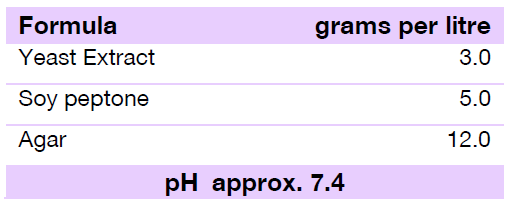Description
Yeast Extract Agar | DM496D
A medium for the enumeration of microorganisms in water.
MAST Yeast Extract Agar for the enum-eration of micro-organisms in water is prepared according to recommendations in "The Bacteriological Examination of Drinking Water Supplies 1982"1
Colony counts, using this medium, when performed on a regular basis, give a useful assessment of the general quality of water. Changes in microbial content through, for instance, pollution can be readily detected.
Microbial populations capable of growth at 22°C should be quantified separately from organisms which grow at 37°C. The latter group usually represents contamination from external sources.
Technical Formula

Directions
1. Suspend 20g of the powder in 1 litre or the contents of the sachet in the stated volume of distilled or deionised water.
2. Boil to completely dissolve the agar and distribute 15ml amounts in universal containers.
3. Autoclave at 115°C (10 p.s.i.) for 10 minutes. Allow the medium to cool to 50°C before use.
In Use
1. Prepare an appropriate series of tenfold dilutions of the water sample using sterile ¼ strength Ringers solution as diluent. This can be conveniently prepared using MAST Ringers Tablets (Code R-TAB)
2. Pipette 1ml volumes from the highest dilution into each of two petri dishes. To each dish add 15ml of MAST Yeast Extract Agar cooled to 50°C. Mix the contents using a combination of gentle clockwise and anti-clockwise rotations and to and fro movements.
3. Repeat the procedure with the remaining dilutions and the undiluted sample but prepare four plates for each, two for incubation at 22°C and two for incubation at 37°C.
4. Allow the plates to set.
5. Incubate those plates prepared from the highest dilution and 2 plates of each of the other samples at 20-22°C for three days. Incubate the remaining plates at 37°C for 24 hours.
6. When incubation is complete count the number of colonies grown in the plates containing the undiluted samples unless there are more than 300 colonies. In this instance count from a diluted sample in which the number of colonies lies between 30 and 300. If the plate containing the highest dilution produces more than 300 colonies then an approximation has to be made. In each instance two plates should be counted.
7. Average the count from the pairs of plates selected. Multiply the result by the dilution factor for the final report.






